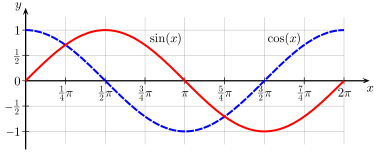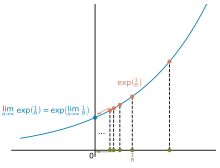Continuous function
In mathematics, a continuous mapping or continuous function is a function in which sufficiently small changes in the argument result in only arbitrarily small changes in the function value. One can formalize this property with the interchangeability of the function with limit values or with the ε 

In visual terms, a real continuous function 
Many functions used in the practice of real analysis are continuous, in particular this is the case for all differentiable functions.
For continuous functions a number of useful properties can be proved. Examples are the intermediate value theorem, the theorem of minimum and maximum and the fundamental theorem of calculus.
More generally, the concept of continuity of mappings is central to mathematics, especially in the subfields of analysis and topology. It is possible to characterize continuity by a condition that uses only terms of topology. Thus the notion of continuity can be extended to functions between topological spaces. This general view turns out to be the most "natural" approach to the notion of continuity from a mathematical point of view: continuous functions are those functions between topological spaces which are "compatible" with their structures. Thus, continuous functions play a similar role in topology and analysis as homomorphisms do in algebra.
Motivation
The function
"jumps" at the point 
The mathematical notion of continuity attempts to accurately describe those functions that do not have such "arbitrary" behavior. Thus, the given function 

Continuity is often associated with being able to draw the graph of a function in one go, without having to drop it. This view reaches certain limits, especially when considering functions with other ranges of definition than the entire real number line. Therefore mathematically exact definitions are needed.
For example, the
given function is clearly continuous, because except at 

Detailed study of the behavior of 

The function 





















Sine and cosine are continuous functions, their function graphs can be drawn in one go without stopping.
Continuity of real functions
Definition
Let 


In real analysis, there are several equivalent ways to define the continuity of 

Definition by epsilon delta criterion. 




applies:

Intuitively, the continuity condition means that for every change ε 

Example: Prove continuity of the function 
Let 


It's

To make this smaller than the given number ε 
be chosen. Because from
then follows namely

Comments:
- Since the function
at every point
is continuous, is
thus continuous on all of
continuous.
- Because δ
can only be derived from ε
, but not from the location
is
even continuous on all of
uniformly continuous.
Definition by means of limit values. With this definition one demands the interchangeability of function execution and limit value formation. Here one can either rely on the notion of limits for functions or for sequences.
In the first case one formulates: 




In the second case, one formulates: 





The second condition is also called the sequence criterion.
Instead of continuity in 






A function is said to be continuous if it is continuous at every point in its domain.
Examples of continuous and discontinuous functions
If a function is differentiable at one point, it is also continuous there. Thus follows in particular the continuity
- of all rational functions (so, for example,
or
)
- of the exponential functions
, for fixed
- the trigonometric functions (i.e. sine, cosine, tangent,...)
- of the logarithm functions
But the continuity of these functions can be proved directly without recourse to the notion of differentiability.
The absolute value function is also continuous, even if it is not differentiable at the point 0. Also continuous are all power functions (for example 
In fact, all elementary functions are continuous (for example, 
When considering elementary functions, however, it should be noted that some elementary functions have as their domain of definition only a real subset of the real numbers. For example, the square root function omits all negative numbers, and the tangent function omits all zeros of the cosine.
In these cases, it is sometimes imprecisely formulated that the functions are discontinuous in the corresponding places. However, this is not correct, since the question of continuity only arises for points in the domain of definition. Mathematically meaningful, however, is the question of a continuous continuation of the function at a definition gap.
For example, the function
defined for all real numbers 

The absolute value function and the root function are examples of continuous functions that are not differentiable at individual points in the domain of definition. At the beginning of the 19th century, mathematical experts still assumed that a continuous function must be differentiable at least at "most" places. Bernard Bolzano was then the first mathematician to construct a function that is continuous everywhere but differentiable nowhere, the Bolzano function. However, he did not publish his result. In the 1860s, Karl Weierstrass also found such a function, known as the Weierstrass function, which caused a sensation in the mathematical world. The graph of the Weierstrass function can effectively not be drawn. This shows that the intuitive explanation that a continuous function is one whose graph can be drawn without setting down the pencil can be misleading. Ultimately, one must always resort to the exact definition when investigating the properties of continuous functions.
Using methods of 20th century mathematics, it could even be shown that the functions which are nowhere differentiable are in a sense "frequent" among the continuous functions.
Simple examples of discontinuous functions are:
- the sign function (discontinuous only in 0)
- the Dirichlet function (discontinuous at every point)
- the Thomaean function (discontinuous exact in all rational numbers).
Continuity of composite functions
Similar to differentiability, continuity is a property that transfers from the components to the functions composed of them in many operations. For the following points, let the continuity of 

- Consecutive execution: if
is another real function whose domain of definition
spans the range of values of and is
continuous in then the composition is
continuous in
.
- Algebraic operations: If
is another real function with the same domain of definition as
, which is also continuous in
, then the pointwise defined functions
,
,
and
also continuous in
. In the latter case, however, note that the domain of definition of the composite function turns out to be
without the zero set of .
In particular,
may thus not be a zero of
even in this case.
- Maximum/minimum: Under the same conditions as in the previous point, the pointwise defined functions
and are
continuous in
.
If the definition ranges of the functions involved do not match as required, you may be able to help yourself by placing suitable restrictions on the definition ranges.
Under certain conditions continuity also transfers to the inverse function. However, the statement cannot be formulated here for point-wise continuity:
If the domain of the injective continuous real function 


Using these permanence properties, one can derive, for example, the continuity of the elementary function given above 
Main theorems about continuous real functions
There are a number of important theorems that 
![{\displaystyle D_{f}=[a,b]}](https://www.alegsaonline.com/image/324b4edf940ed3b2de16c5aea06fbfa5c28112ab.svg)

- Intermediate value set: the function takes any value between
and
.
- Theorem of Minimum and Maximum:
is bounded and infimum and supremum of its function values are also assumed to be function values. So it is really a matter of minimum and maximum. This theorem proved by Weierstrass, sometimes called the extreme value theorem, only provides the existence of these extreme values. For their practical finding, statements from the differential calculus are often necessary.
- Fundamental theorem of analysis:
is Riemann integrable and the integral function
is a primitive function of 
- Heine's theorem:
satisfies a stricter version of the epsilon-delta criterion. The corresponding property is called uniform continuity.
From the intermediate value theorem and the theorem of minimum and maximum together it follows that the image of is 
Other continuity terms
Tightening of the concept of continuity are, for example, uniform continuity, (local) Lipschitz continuity, Hölder continuity as well as absolute continuity and geometric continuity. Ordinary continuity is sometimes called pointwise continuity to distinguish it from uniform continuity. Applications of Lipschitz continuity can be found, for example, in existence and uniqueness theorems (e.g., Picard-Lindelöf's theorem) for initial value problems of ordinary differential equations and in geometric measure theory. Absolute continuity is used in stochastics and measure theory, geometric continuity in geometric modeling.
One property that a set of functions may possess is uniform continuity. It plays a role in the frequently used theorem of Arzelà-Ascoli.

Example for the sequence criterion: The sequence exp(1/n) converges to exp(0)
Search within the encyclopedia
















